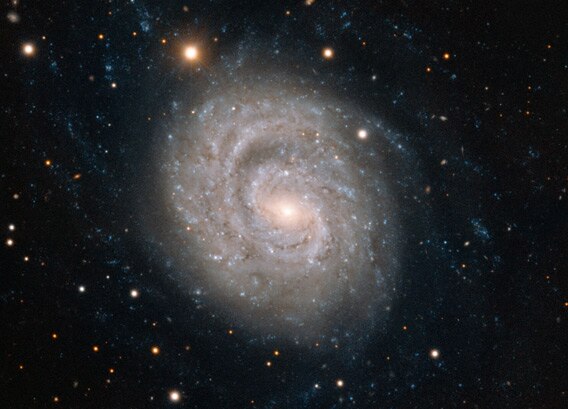Create a free profile to get unlimited access to exclusive videos, sweepstakes, and more!
How Much Is a Supernova Worth?

If I had a nickel for every nickel you could make from the nickel in supernova SN1999em, Iâd be very, very, VERY rich.
If I were you, dear BABloggee, Iâd be thinking, âWhat the what?â So let me explain. Well, let me explain in a minute. First, I want to introduce you to the gorgeous but somewhat lopsided spiral galaxy NGC 1637, care of the Very Large Telescope in Chile:
NGC 1637 is a decent-size spiral galaxy about 26 million light years away. Thatâs pretty close for a galaxy, roughly equivalent to being down the block in our galactic neighborhood. As you can see, itâs noticeably asymmetricâlopsidedâwith the arm to the upper left a lot longer than its counterpart on the other side. This kind of thing is fairly common, occurring in about a third of all spiral galaxies. Itâs even more common when the galaxy is part of a cluster of galaxies, so itâs probably due to gravitational interactions with other galaxies as they pass close by.
The image here is a combination of many pictures taken over quite some time starting in 1999. Why then? Because an exploding star was discovered in late October of that year, given the designation SN1999em (the 143rd such exploding star to be discovered that year*). Because the galaxy is fairly close, this explosion got bright enough to be seen even with small telescopes, and it became one of the best observed supernovae of its day.
The Very Large Telescope was used to observe it many times, getting great shots of the host galaxy NGC 1637 as well as important observations of the supernova. The star was probably about eight times the mass of the Sun when it went kablooie. Stars like that create a lot of heavy elements in their core: oxygen, carbon, silicon, and nickel, to name a few. When the star explodes, a lot of energy is generated, and those materials are scattered at very high speed. Not only that, new elements are created in the blast as the nuclei of these elements get slammed by subatomic particles from the blast.
One of these elements is nickel (âAHA!â I hear you thinking, âFinally!â). The kind of nickel made specifically is nickel-56, usually written 56Ni. Itâs radioactive, and decays into cobalt-56 which in turn decays into iron-56. Do you see any iron materials around you? Maybe steel in your desk, or in the girders in your house or building. Or maybe youâre bleeding. If you are, go take care of that, but as you do so note that your blood is red due to the molecule hemoglobin, which transports oxygen in your body to where you need it. Hemoglobin is a complicated molecule, but at its center isâyou guessed itâiron. That iron was almost certainly produced in some ancient exploding star billions of years ago.
But back to nickel. How much was blown out in SN1999em, specifically? It turns out the total nickel in the supernova was about 0.02 times the mass of the Sun. The Sun has a mass of 2 x 1027 tons, so the mass of nickel created in the supernova was 4 x 1025 tons. So, yeah, a lot of nickel. If you could gather up all that nickel you could make a planet the size of Jupiter, a thousand times the volume of the Earth. A pure nickel planet. Cool.
So, to coin a phrase: We are star stuff.
But how much money is that in actual nickels? A U.S. nickel has a mass of five grams. But we have to be careful: only ¼ of the mass of a nickel is actually nickel; the other ¾ is copper. So letâs assume we have an infinite supply of copper somewhere to add to our stash of nickel nickels, and we only need 1.25 grams of nickel per nickel.
The supernova expelled 4 x 1031 grams of nickel, which would make 3.2 x 1031 nickels. As I mentioned, thatâs a lot. If you stacked them (given their thickness of 1.95 mm) theyâd stretch clear across the Universeâ¦dozens of times. I had to check my math several times for that because I simply couldnât believe it. Itâs insane.
And how much money is that?
It would be the tidy sum of $1.6 x 1030, or 1.6 million trillion trillion dollars.
1,600,000,000,000,000,000,000,000,000,000 dollars. Huh.
With that much money you could pay off the entire U.S. national debt 100 quadrillion times, and still have enough spare change to get a few billion cups of coffee. With extra cream. Even at Starbucks.
Sounds like a great get-rich plan! The only trouble is the nickel from a supernova is a) at a temperature of thousands of degrees, 2) spread out over several cubic light years of space, γ) expanding at several thousand kilometers per second, and iv) remember, highly radioactive, releasing enough energy to power the glow of the supernova for several weeks. Also, in this particular case, itâs located 26 million light years away, so there may prohibitively high transportation costs.
Ah well. I never really planned on getting rich from astronomy. Itâs actually payment enough having so much fun figuring this stuff out.
[Note to my editor: Itâs not actually payment enough. Please pay me. Just not with nickels.]
[* Correction (Mar. 21, 2013): I initially and erroneously said SN1999em was the 147th supernova that year. My apologies to SN199eq.]


























